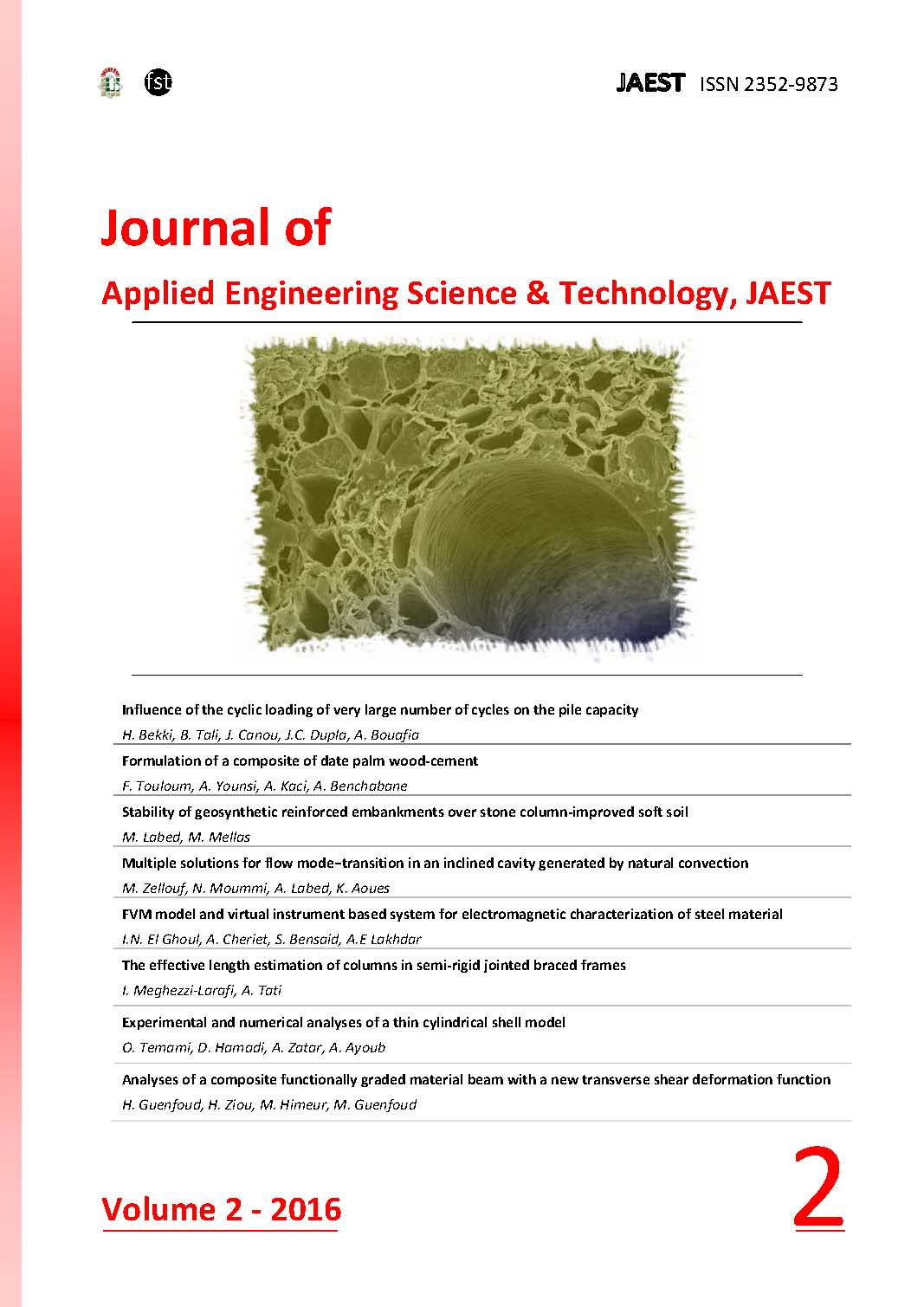Experimental and numerical analyses of a thin cylindrical shell model
Abstract
The analysis of thin shell structures is generally based on theoretical principles. The experimental tests on this type of structure are important for understanding the effect of loading and the geometrical shapes on its mechanical behavior. In this paper, an experimental test of a cylindrical shell under the effect of concentrated static loads is presented. A comparative numerical study is carried out by using two finite elements: the first element called ACM_RSBE5, recently formulated, and the second one, S4R, of ABAQUS code are used for the study of thin shells. The experimental results are compared with those obtained numerically. The results of both elements, ACM-RSBE5 and S4R, are in agreement with those obtained experimentally. The efficiency and the importance of the approach of the flat shell element for thin shell structures are confirmed.References
Abaqus (2011) Version 6.14. Dassault Systemes Simulia Corporation.
Adini, A., R. W. Clough (1961) Analysis of plate bending by the finite element method, Report to the Nat. Sci. Found., U.S.A., G 7337.
Ashwell, D. G., A. B. Sabir (1972) A new cylindrical shell finite element based on simple independent strain function, International Journal of Mechanical Sciences 14 (03): 171-183.
Cook, R. D. (1994) Four-node ‘flat’ shell element: drilling degrees of freedom, membrane–bending coupling, warped geometry, and behavior, Computers and Structures 50(4): 549-555.
Djoudi, M. S., H. Bahai (2003) A shallow shell finite element for the linear and nonlinear analysis of cylindrical shells. Engineering structures (25): 769- 778.
Hamadi, D., A. Ayoub, O. Abdelhafid (2015) A new flat shell finite element for the linear analysis of thin shell structures, European Journal of Computational Mechanics 24(6): 232-255.
Katili, I. , J. L., Batoz, J. M., Imam, A., Hamdouni, O. Millet (2015) The development of DKMQ plate bending element for thick to thin shell analysis based on the Naghdi/Reissner/Mindlin shell theory, Finite Elements in Analysis and Design 100:12–27.
Melosh, R. J. (1963) Basis of derivation of matrices for the direct stiffness method, J.AIAA 1(7): 1631-1637.
Poulsen, P. N., L. Damkilde (1996) A flat triangular shell element with loof nodes, International Journal for Numerical Methods in Engineering, 39(22): 3867-3887.
Zienkiewicz, O. C. (1977) The finite element method, McGraw-Hill, (UK) London.
Adini, A., R. W. Clough (1961) Analysis of plate bending by the finite element method, Report to the Nat. Sci. Found., U.S.A., G 7337.
Ashwell, D. G., A. B. Sabir (1972) A new cylindrical shell finite element based on simple independent strain function, International Journal of Mechanical Sciences 14 (03): 171-183.
Cook, R. D. (1994) Four-node ‘flat’ shell element: drilling degrees of freedom, membrane–bending coupling, warped geometry, and behavior, Computers and Structures 50(4): 549-555.
Djoudi, M. S., H. Bahai (2003) A shallow shell finite element for the linear and nonlinear analysis of cylindrical shells. Engineering structures (25): 769- 778.
Hamadi, D., A. Ayoub, O. Abdelhafid (2015) A new flat shell finite element for the linear analysis of thin shell structures, European Journal of Computational Mechanics 24(6): 232-255.
Katili, I. , J. L., Batoz, J. M., Imam, A., Hamdouni, O. Millet (2015) The development of DKMQ plate bending element for thick to thin shell analysis based on the Naghdi/Reissner/Mindlin shell theory, Finite Elements in Analysis and Design 100:12–27.
Melosh, R. J. (1963) Basis of derivation of matrices for the direct stiffness method, J.AIAA 1(7): 1631-1637.
Poulsen, P. N., L. Damkilde (1996) A flat triangular shell element with loof nodes, International Journal for Numerical Methods in Engineering, 39(22): 3867-3887.
Zienkiewicz, O. C. (1977) The finite element method, McGraw-Hill, (UK) London.
Published
2016-12-22
How to Cite
TEMAMI, Oussama et al.
Experimental and numerical analyses of a thin cylindrical shell model.
Journal of Applied Engineering Science & Technology, [S.l.], v. 2, n. 2, p. 99-103, dec. 2016.
ISSN 2571-9815.
Available at: <https://revues.univ-biskra.dz/index.php/jaest/article/view/1897>. Date accessed: 31 may 2025.
Issue
Section
Section B: Thermal, Mechanical and Materials Engineering
Keywords
Experimental test; Cylindrical shell model; Flat shell element; Numerical analysis
J. Appl. Eng. Sci. Technol. (JAEST - ISSN 2352-9873) is a peer-reviewed quarterly journal dedicated to the applied engineering sciences and technology. The JAEST provides immediate open access to its content on the principle that making research freely available to the public supports a greater global exchange of knowledge.
There is no submission or publication fee for papers published in the JAEST.
Authors who publish in the JAEST agree to the following terms:
- Authors retain copyright and grant the journal right of first publication with the work simultaneously licensed under a Creative Commons Attribution License that allows others to share the work with an acknowledgement of the work's authorship and initial publication in the JAEST.
- Authors are able to enter into separate, additional contractual arrangements for the non-exclusive distribution of the journal's published version of the work (e.g., post it to an institutional repository or publish it in a book), with an acknowledgement of its initial publication in the JAEST.
- Authors are permitted to post their work online (e.g., in institutional repositories or on their website) prior to and during the submission process, as it can lead to productive exchanges, as well as earlier and greater citation of published work (See The Effect of Open Access). Any such posting made before acceptance and publication of the Work shall be updated upon publication to include a reference to the JAEST and a link to the online abstract for the final published Work in the Journal.






